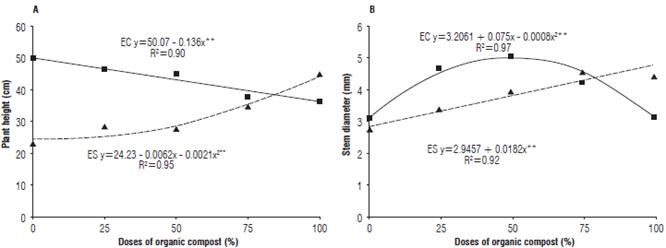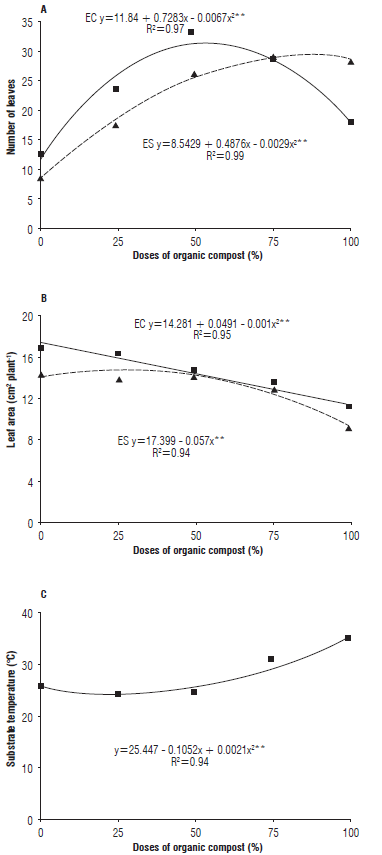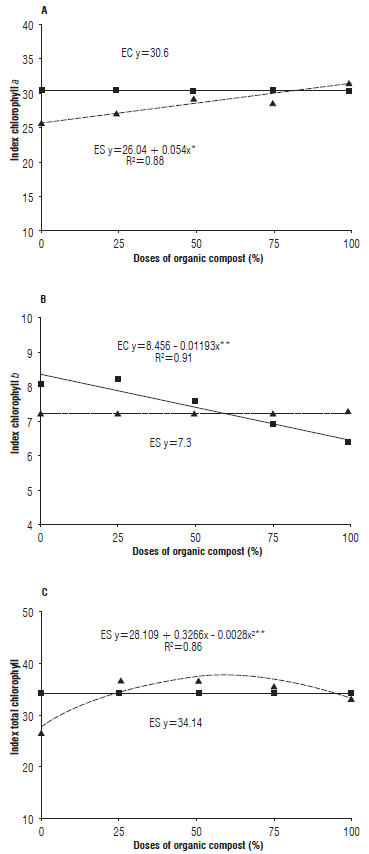Introduction
In the present study, some responses by umbuzeiro (Spondias tuberosa Arr. Cam.) to organic inputs were evaluated. The umbuzeiro is an endemic plant of the Caatinga biome characterized by a seasonally dry tropical forest (Mertens et al., 2017).
Among the tropical and subtropical fruits grown in the northeast region of Brazil, fruits of the genus Spondias, such as umbu (Spondias tuberosa) and umbu-cajá (Spondias sp.), are generally consumed in natura, as juice and in the form of ice cream (Galvão et al., 2011; Medeiros et al., 2015). Umbu fruit has great prominence and acceptance by consumers in the north and northeast of Brazil, mainly because of its pleasant, refreshing, acidic taste with high antioxidant activity (Zeraik et al., 2016).
The umbuzeiro is a species highly adapted to semi-arid regions, with long periods of drought in the dry season. This fruit represents an additional income for farmers in the dry season because it is a nutritious food for humans (Lins Neto et al., 2010). Despite the high demand in the northeastern region for umbu fruits, there are no commercial plantations and production is exclusively extractive (Costa et al., 2015).
This species is dicotyledonous and can be propagated by cutting, grafting or, predominantly, seeds. The plants originating from seeds have pivotal roots, a structure that cannot be observed in the plants originating from cuttings. Seed-derived plants become more resistant to tipping caused by strong winds (Reis et al., 2010).
In order to evaluate adaptation of Spondia tuberosa in different conditions, the response of its root system to soil changes should be evaluated. Additionally, seedling growth and development with the use of organic substrates and fertilizers that improve soil and consequently the plant's nutrition should be monitored for the development of this species in natural conditions (Cruz et al., 2016; Mertens et al., 2017).
The use of organic fertilization in agriculture with crop residues and animal manure has been highlighted as one of the main strategies for agriculture with sustainable use and management, especially in regions with low fertility soils (Chiti et al., 2012; Ansari and Mahmood, 2017). When properly managed, organic residues from agricultural activities such as crop residues and animal manure, can also be used as substrates for seedling production (Cavalcante et al., 2016; Mota et al., 2018). Organic fertilizers stimulate the production of extracellular enzymes (Medeiros et al., 2014) that contribute to the gradual release of nutrients and substances that stimulate plant growth (Silva et al., 2013).
Because of the scarcity of information on the development of umbuzeiro seedlings, the objective was to evaluate the growth, substrate temperature and chlorophyll indexes in umbu seedlings at organic compound levels in the substrate and with organic foliar fertilizer applications.
Materials and methods
This experiment was conducted from July to October, 2015 in a protected environment belonging to the Center for Human, Social and Agricultural Sciences (CCHSA) at the Federal University of Paraíba (UFPB), Bananeiras-Paraíba, Brazil.
The experiment design used randomized blocks in a 5x2 factorial arrangement, with four replicates and three plants per experiment unit. The factors corresponded to the substrates for sowing (0, 25, 50, 75 and 100% of organic compound) in the substrate, with and without foliar applications of 1% organic foliar fertilizer (EcoLife®, Palm Harbour, Florida, USA). The composition of the organic foliar fertilizer is described in Supplementary material 1.
For the preparation of the organic compound, rabbit manure was used and rest of cultures (brachiaria, common bean and jackfruit). The soil used was collected at a depth of 0 to 20 cm in a Dystrophic Yellow Latosol classified according to the criteria of the Brazilian Soil Classification System - SiBCS (EMBRAPA, 2013). The foliar application of the organic fertilizer was carried out at 20, 40 and 60 d after transplanting the seedlings to the bag, at a concentration of 1% of the organic input.
The seeds were collected in the Riachão municipal district, Paraíba, Brazil. Then, the seeds were taken to the soil laboratory, where the endocarp was removed with sandpaper (number 120) in the distal part of the seeds to avoid damaging the embryo (Melo et al., 2012).
The seeds were allowed to germinate on polyethylene trays containing vermiculite as the substrate, with emergence starting 25 d after sowing, with a duration of10 d. After 40 d of emergence, the seedlings were transplanted to 18x30 cm polyethylene bags. After 90 d, when the seedlings were fit to be taken to the field, the following biometric variables were analyzed: stem diameter, which was measured with a digital caliper, plant height, with a ruler graduated in centimeters, number of leaves, leaf area, a, b and total chlorophyll indexes, which were measured with a portable chlorophyll meter (ClorofilLOG® CFL 1030, Falker, Brazil) and substrate temperature at 12 pm with the help of a Digital Infrared Thermometer (AK35new, Akso, Brazil).
The data were compiled to perform an analysis of variance (F test, P<0.05). The mean values for the organic foliar fertilizer application were compared by the F test, which in this case was conclusive; the means of the substrate composition were compared by regression. A statistical analysis was carried out using SISVAR version 5.3 (Ferreira, 2011).
TABLE 1 Data of chemical analysis of the soil and the organic compound used in the substrate composition.

* pH in water; OC: organic compost; BS: base sum (Ca2+ + Mg2+ + K+); CTC: cation exchange capacity [BS + (H+ + Al3+); V: saturation by exchangeable bases (BS/CTC)*100; OM: Organic matter; M: Al+3 saturation.
Results and discussion
The analysis of variance (Tab. 2) verified that the organic compound x foliar fertilization interaction exerted a significant influence on the plant height, stem diameter, number of leaves, leaf area, chlorophyll b index, and total chlorophyll index and an isolated effect on the substrate temperature and chlorophyll a index.
TABLE 2 Summary of analysis of variance, including mean values of the variables plant height (PH), stem diameter (SD), number of leaves (NL), leaf area (LA), substrate temperature (ST), chlorophyll a index (ICa), chlorophyll b index (ICb) and total chlorophyll index (ICt).

SV: source of variation; DF: degrees of freedom; CV: coefficient of variation; ** and * significant at 1% and 5% probability, respectively; ns: not significant at 1% and 5% probability.
The height of the umbuzeiro seedlings was higher in the treatments with organic compost with up to 50% of the organic compound in the substrate and foliar fertilization with organic foliar fertilizer at 90 d after transplanting the seedlings in polyethylene bags (Fig. 1A). According to Cruz et al. (2016), the use of 40 to 50% organic matter with bovine manure in the substrate provided better growth of the umbuzeiro seedlings because of nutritional balance in the substrate, increasing the availability of nutrients to the seedlings.
Organic fertilizers cause the production of extracellular enzymes (Medeiros et al., 2014) as a result of maintenance and stimulation of enzymatic activity in the presence of the organic material (Li et al., 2018a). This contributes to the gradual release of nutrients and substances that stimulate plant growth (Silva et al., 2013). The foliar application of organic fertilizer may have contributed simultaneously to the growth of the umbuzeiro seedlings.
The treatments with organic compost and applications of organic foliar fertilizer at the estimated dose of 46.9% of the organic compound in the substrate provided the best seed diameters of the seedlings (Fig. 1B). These results may have resulted from improvement in nutrient balance of the substrate, as well as the improvement in water availability and nutrient retention near the root, which is a limiting factor for growth in umbuzeiro plants (Mertens et al., 2017). The addition of organic matter increases the contents of fulvic acid and humic acid in the organic matter, which can favor the growth and development of seedlings (Bacilio et al., 2016).

FIGURE 1 Plant height (A) and stem diameter (B) of the umbuzeiro seedlings in organic substrate with EC (-) and without ES (---) organic foliar fertilizer applications. *significant at 1% and ** significant at 5% probability.
For the number of leaves per umbuzeiro plant, the treatments with organic compounds at the estimated dose of 54.4% with organic foliar fertilizer applications and 84% organic compound in the substrate without organic foliar fertilizer provided the best results (Fig. 2A). The addition of leaf fertilization with an organic foliar fertilizer increases the availability of nitrogen to plants, as well as a plant's resistance to pathogens (Nascimento et al., 2008), which may have favored an increase in the number of leaves and leaf area in the umbuzeiro seedlings in this study (Fig. 2B). The organic foliar fertilizer EcoLife® is a commercial product composed of bioflavonoids; in addition to improving plant resistance to stress, this product has a synergistic action between its components and can regulate vegetative vigor, causing better growth in plants (Cavalcanti et al., 2006; Furtado et al., 2010).

FIGURE 2 Number of leaves (A), leaf area (B) and substrate temperature (C) in the umbuzeiro seedlings in the organic substrate with EC (-) and without ES (---) organic foliar fertilizer applications. * significant at 1% and ** significant at 5% probability.
The temperature was higher in the substrates with more than 75% organic compound, which may have increased the accumulation of heat and, consequently, the temperature (Fig. 2C). According to Li et al. (2017), soil temperature may directly influence seedling growth. The increase of organic matter in a substrate can raise its temperature and consequently influence the growth of seedlings (Hartley and Ineson, 2008; Conant et al., 2011; Moinet et al., 2018).
The chlorophyll a and b rates increased in the organic foliar fertilizer treatments. For the total chlorophyll index, the best results were obtained in the treatments without applications of the organic foliar fertilizer at an estimated dose of 58% organic compound in the substrate (Fig. 3). In order to obtain a better balance of organic residues in the substrate, it is possible to provide better conditions and relative chlorophyll indexes in the seedlings, which may favor light uptake by chlorophyll and consequently improve the photosynthetic regulation of the plants (Braga et al., 2017; Li et al., 2018b).

FIGURE 3 Chlorophyll a index (A), chlorophyll b index (B) and total chlorophyll index (C) in the umbuzeiro seedlings in the organic substrate with EC (-) and without ES (---) foliar applications of the organic foliar fertilizer. * significant at 1% and ** significant at 5% probability.
According to Mota et al. (2018), the evaluation of chlorophyll in seedlings growing in substrates with organic residues is a quick and simple way to increase the quality of seedlings.
Conclusions
The substrate with up to 58% of the estimated dose of organic compound with organic foliar fertilizer applications provided better growth in terms of height, stem diameter and number of leaves.
The temperature of the substrate increased regardless of the proportion of the substrate or the application of the organic foliar fertilizer.
The indexes of chlorophyll a and b were higher in treatments with the organic foliar fertilizer up to the dose of 50% organic compound in the substrate, and the total chlorophyll was higher in the treatments without the organic fertilizer at the estimated dose of 58% organic compound in the substrate.
















